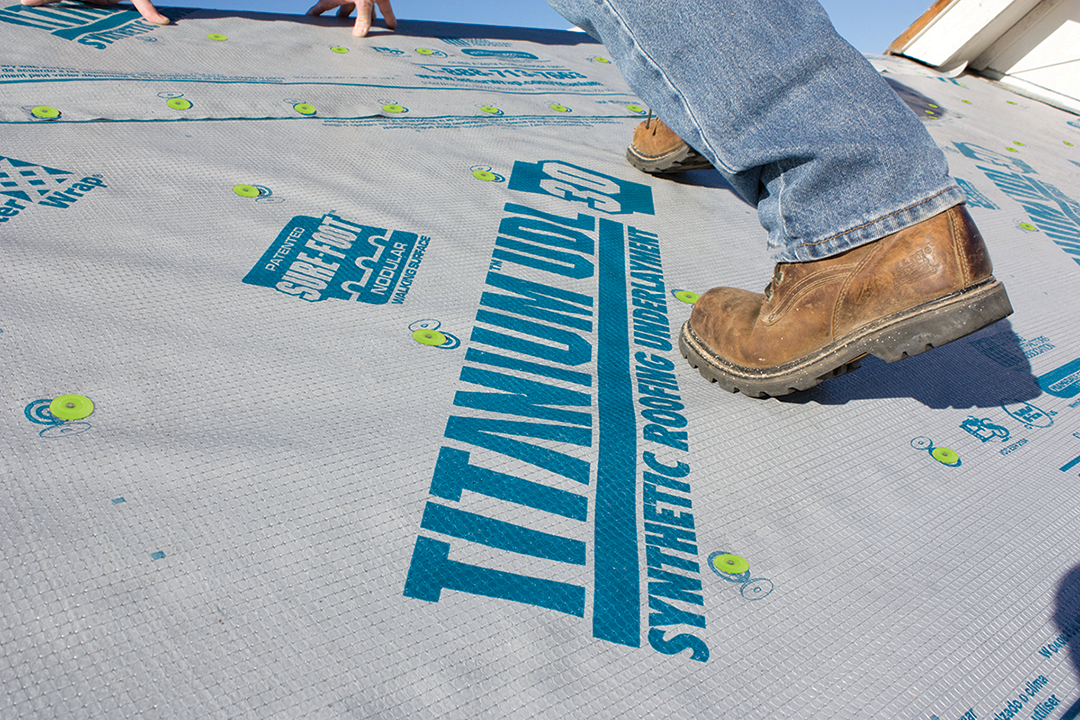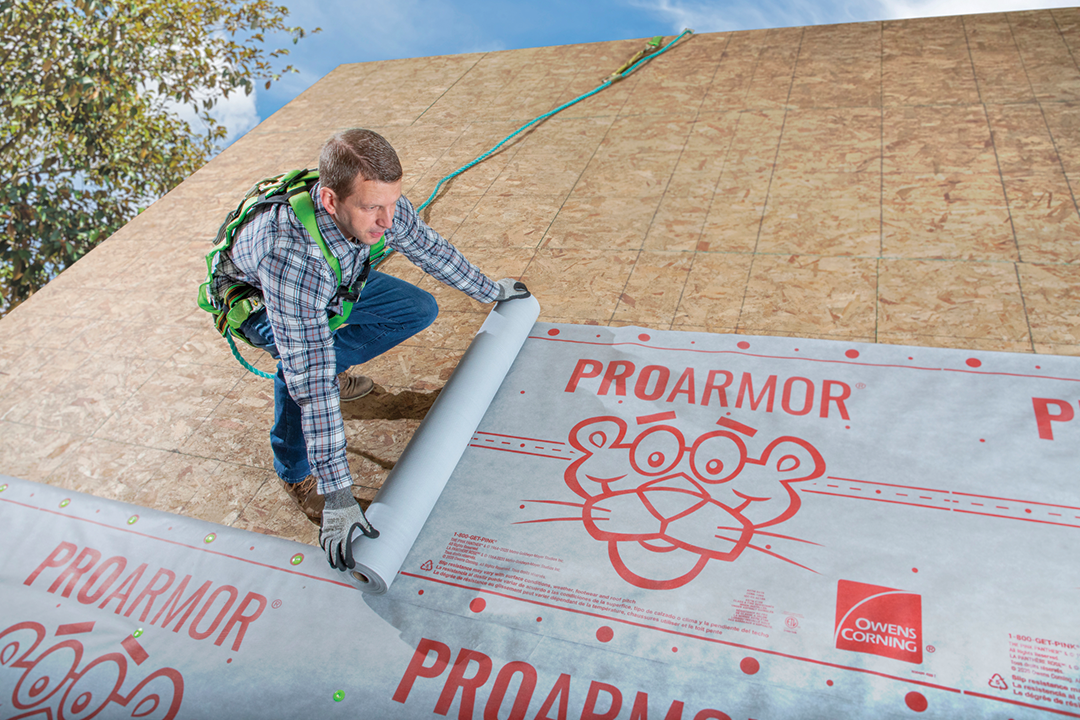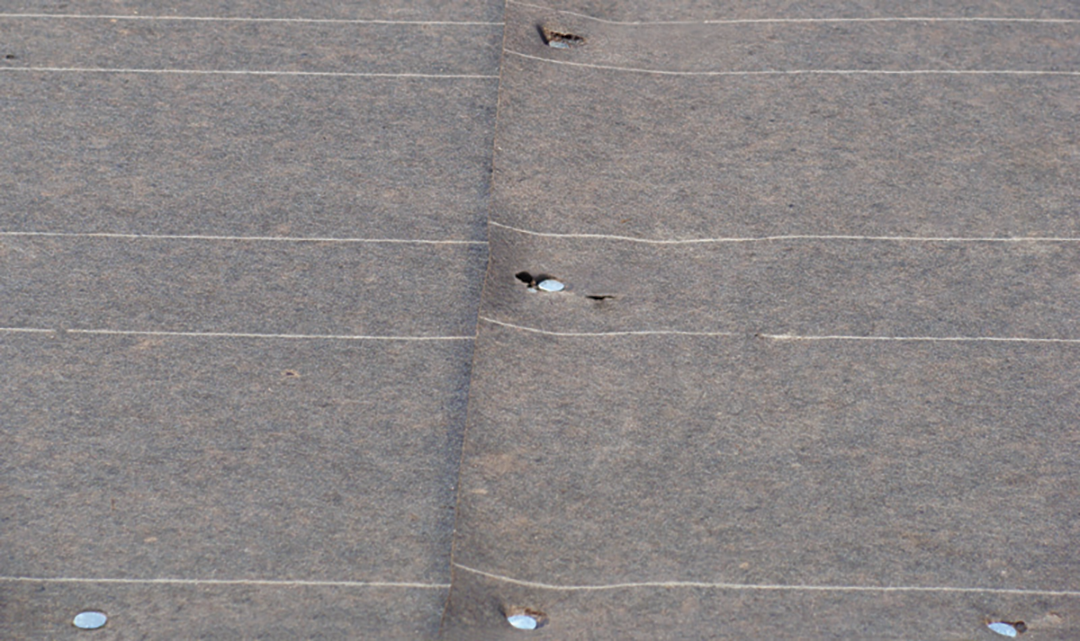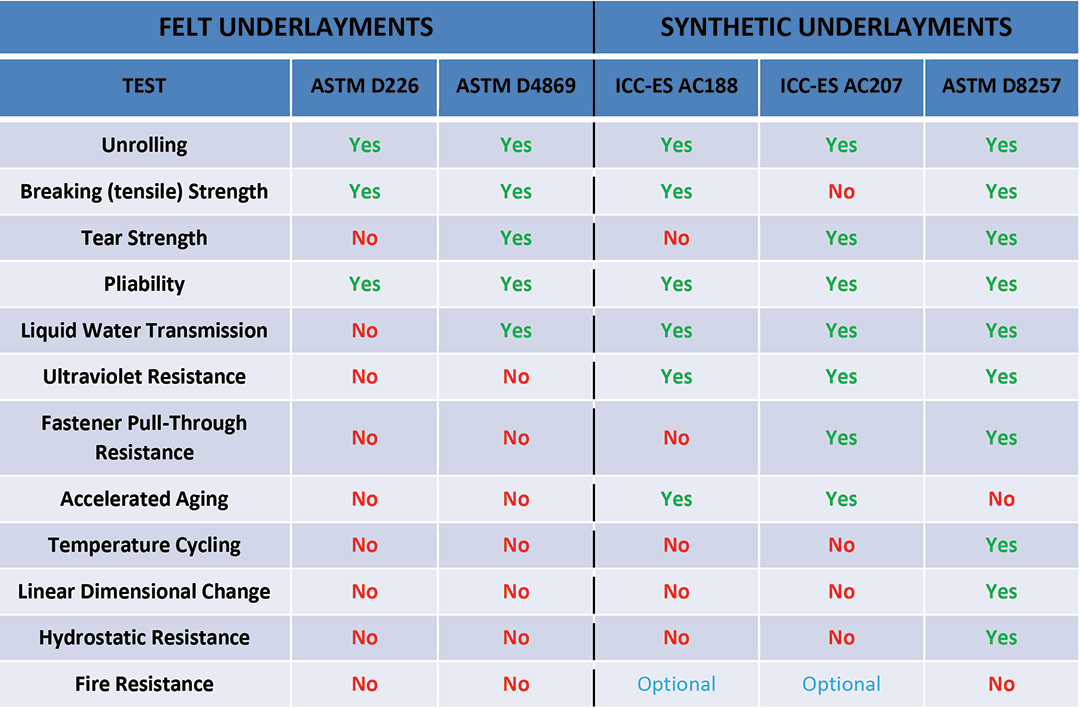As you well know, synthetic underlayments have been available for more than 20 years, but early versions left a bad impression on some contractors. However, things have changed for the better.
Why synthetic underlayment?
Roofing contractors always are looking for ways to do their jobs more efficiently and provide product choices they believe will improve the quality and durability of the roof systems they install. Asphalt felt underlayments, also referred to as felt paper or tar paper, have served the roofing industry well for decades. However, there have been shortcomings with these products. As the monikers indicate, the most prevalent drawback to these products is they essentially are paper saturated with asphalt.
The organic paper core of these products is sensitive to changes in humidity. Because the paper core isn’t 100% saturated, the paper still can absorb moisture, which can cause waviness when installed on a roof. Generally, the heavier the paper core, the more potential waviness is possible.
Another major drawback of these products is their propensity to tear easily. Tearing is a concern especially if it occurs around fasteners when a product is enduring foot traffic during roof covering installation. Tearing also is a major concern when it comes to underlayments’ ability to remain in place during a high-wind event, especially if the primary roof covering is blown off.
These concerns were the primary drivers for developing synthetic underlayments. Synthetic underlayments are designed to provide superior strength—resistance against tensile pulling and tearing. However, the test standards for these products hadn’t caught up to product development until now.
History of testing

Several synthetic underlayment manufacturers worked with the International Code Council—Evaluation Service to develop acceptance criteria for synthetic underlayments.
Early synthetic underlayments were tested and qualified for use under ASTM International standards that were intended to be applied to asphalt-impregnated felt underlayments. For many years, the I-Codes and the Florida Building Code have referenced ASTM D226, “Standard Specification for Asphalt-Saturated Organic Felt Used in Roofing and Waterproofing,” ASTM D4869, “Standard Specification for Asphalt-Saturated Organic Felt Underlayment Used in Steep Slope Roofing,” and ASTM D6757, “Standard Specification for Underlayment Felt Containing Inorganic Fibers Used in Steep-Slope Roofing.”
These standards are intended to apply to asphaltic felt underlayments. The problem with this approach is the standards are primarily composition-driven. Because the standards are intended to be applied to asphaltic underlayments, minimal testing can be performed on synthetic underlayments. In fact, when a synthetic underlayment is tested under ASTM D226, for instance, the only tests that can be applied are the unrolling, breaking strength and pliability tests. Those who have installed underlayment know these three tests alone demonstrate little about a product’s suitability.

Members of ASTM International’s Committee D08 on Roofing and Waterproofing worked for eight years to develop a standard that establishes appropriate and stringent performance requirements for synthetic underlayments.
It didn’t take long for the roofing industry to recognize the unsuitability of the existing felt standards for assessing synthetic underlayments. As a result, several synthetic underlayment manufacturers worked with the International Code Council®—Evaluation Service to develop acceptance criteria for synthetic underlayments. Acceptance criteria are similar to ASTM International standards but with a couple of distinct differences:
- They are not consensus-based standards. The test requirements and conditions of acceptance are determined by the manufacturer and ICC-ES with limited input from industry stakeholders.
- The acceptance criteria cannot be referenced in the I-Codes as a reference standard.
Acceptance criteria are deemed to be an alternative compliance path that applies to products for which the codes do not include
As you well know, synthetic underlayments have been available for more than 20 years, but early versions left a bad impression on some contractors. However, things have changed for the better.
Why synthetic underlayment?
Roofing contractors always are looking for ways to do their jobs more efficiently and provide product choices they believe will improve the quality and durability of the roof systems they install. Asphalt felt underlayments, also referred to as felt paper or tar paper, have served the roofing industry well for decades. However, there have been shortcomings with these products. As the monikers indicate, the most prevalent drawback to these products is they essentially are paper saturated with asphalt.
The organic paper core of these products is sensitive to changes in humidity. Because the paper core isn’t 100% saturated, the paper still can absorb moisture, which can cause waviness when installed on a roof. Generally, the heavier the paper core, the more potential waviness is possible.
Another major drawback of these products is their propensity to tear easily. Tearing is a concern especially if it occurs around fasteners when a product is enduring foot traffic during roof covering installation. Tearing also is a major concern when it comes to underlayments’ ability to remain in place during a high-wind event, especially if the primary roof covering is blown off.
These concerns were the primary drivers for developing synthetic underlayments. Synthetic underlayments are designed to provide superior strength—resistance against tensile pulling and tearing. However, the test standards for these products hadn’t caught up to product development until now.
History of testing

Several synthetic underlayment manufacturers worked with the International Code Council—Evaluation Service to develop acceptance criteria for synthetic underlayments.
Early synthetic underlayments were tested and qualified for use under ASTM International standards that were intended to be applied to asphalt-impregnated felt underlayments. For many years, the I-Codes and the Florida Building Code have referenced ASTM D226, “Standard Specification for Asphalt-Saturated Organic Felt Used in Roofing and Waterproofing,” ASTM D4869, “Standard Specification for Asphalt-Saturated Organic Felt Underlayment Used in Steep Slope Roofing,” and ASTM D6757, “Standard Specification for Underlayment Felt Containing Inorganic Fibers Used in Steep-Slope Roofing.”
These standards are intended to apply to asphaltic felt underlayments. The problem with this approach is the standards are primarily composition-driven. Because the standards are intended to be applied to asphaltic underlayments, minimal testing can be performed on synthetic underlayments. In fact, when a synthetic underlayment is tested under ASTM D226, for instance, the only tests that can be applied are the unrolling, breaking strength and pliability tests. Those who have installed underlayment know these three tests alone demonstrate little about a product’s suitability.

Members of ASTM International’s Committee D08 on Roofing and Waterproofing worked for eight years to develop a standard that establishes appropriate and stringent performance requirements for synthetic underlayments.
It didn’t take long for the roofing industry to recognize the unsuitability of the existing felt standards for assessing synthetic underlayments. As a result, several synthetic underlayment manufacturers worked with the International Code Council®—Evaluation Service to develop acceptance criteria for synthetic underlayments. Acceptance criteria are similar to ASTM International standards but with a couple of distinct differences:
- They are not consensus-based standards. The test requirements and conditions of acceptance are determined by the manufacturer and ICC-ES with limited input from industry stakeholders.
- The acceptance criteria cannot be referenced in the I-Codes as a reference standard.
Acceptance criteria are deemed to be an alternative compliance path that applies to products for which the codes do not include prescriptive requirements. Additionally, they are limited to use exclusively for purposes of obtaining an ICC-ES Evaluation Report. The two applicable acceptance criteria are AC 188, “Roof Underlayments,” and AC 207, “Polypropylene Roof Underlayments,” which is limited to spun bond polypropylene underlayments.
Developing a standard

Tearing of asphalt felt underlayment is a concern, especially where it occurs around fasteners.
After years of increasing numbers of synthetic underlayment products being introduced into the market with no defined process for qualifying the underlayments, the roofing industry decided it was time to develop a consensus standard for these products.
During an eight-year period, members of ASTM International’s Committee D08 on Roofing and Waterproofing formed a task group to develop a standard that establishes appropriate, stringent performance requirements for synthetic underlayments. Task group members represent roofing contractors, roof consultants, product manufacturers, test labs, test equipment manufacturers and others. This diverse membership lends credibility to the process and resulting standard, ASTM D8257, “Standard Specification for Mechanically Attached Polymeric Roof Underlayment Used in Steep Slope Roofing.”
ASTM D8257

Differences among felt-based ASTM standards, ICC-ES acceptance criteria and the new ASTM D8257 standard
This standard establishes expectations for synthetic underlayment performance and durability. It has many test requirements that are unprecedented for underlayment standards, including fastener pull-through, ultraviolet resistance and hydrostatic resistance.
To illustrate the benefits of synthetic products tested and approved in accordance with ASTM D8257, the figure compares the differences among various felt-based ASTM standards, ICC-ES acceptance criteria and ASTM D8257.
What’s next
The next step in the process is to propose inclusion of the new standard into the I-Codes and the Florida Building Code. This work currently is underway, and there are many industry stakeholders in support of the effort.
The underlayment technology currently available provides a diverse array of products. Product innovation continues to improve existing products and provide an even wider variety of products to complete your next job.
Greg Keeler is technical services leader for Owens Corning Science and Technology, Granville, Ohio.
requirements. Additionally, they are limited to use exclusively for purposes of obtaining an ICC-ES Evaluation Report. The two applicable acceptance criteria are AC 188, “Roof Underlayments,” and AC 207, “Polypropylene Roof Underlayments,” which is limited to spun bond polypropylene underlayments.Developing a standard

Tearing of asphalt felt underlayment is a concern, especially where it occurs around fasteners.
After years of increasing numbers of synthetic underlayment products being introduced into the market with no defined process for qualifying the underlayments, the roofing industry decided it was time to develop a consensus standard for these products.
During an eight-year period, members of ASTM International’s Committee D08 on Roofing and Waterproofing formed a task group to develop a standard that establishes appropriate, stringent performance requirements for synthetic underlayments. Task group members represent roofing contractors, roof consultants, product manufacturers, test labs, test equipment manufacturers and others. This diverse membership lends credibility to the process and resulting standard, ASTM D8257, “Standard Specification for Mechanically Attached Polymeric Roof Underlayment Used in Steep Slope Roofing.”
ASTM D8257

Differences among felt-based ASTM standards, ICC-ES acceptance criteria and the new ASTM D8257 standard
This standard establishes expectations for synthetic underlayment performance and durability. It has many test requirements that are unprecedented for underlayment standards, including fastener pull-through, ultraviolet resistance and hydrostatic resistance.
To illustrate the benefits of synthetic products tested and approved in accordance with ASTM D8257, the figure compares the differences among various felt-based ASTM standards, ICC-ES acceptance criteria and ASTM D8257.
What’s next
The next step in the process is to propose inclusion of the new standard into the I-Codes and the Florida Building Code. This work currently is underway, and there are many industry stakeholders in support of the effort.
The underlayment technology currently available provides a diverse array of products. Product innovation continues to improve existing products and provide an even wider variety of products to complete your next job.
Greg Keeler is technical services leader for Owens Corning Science and Technology, Granville, Ohio.



